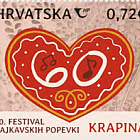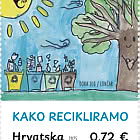Croatian Flora
Bilberry
Vaccinium myrtillus L., Ericaceae Family
Common bilberry is a perennial, deciduous shrub that branches out. It grows up to the heights between 30 and 60 cm. It has shiny green, narrow and very angular shoots (branches) that grow from long underground offshoots (rhizomes). The surface root is very developed and many offshoots sprout from it during spring and fall time, especially from damaged sections usually caused by wild animals. Light green leaves on small stems are 1-3 cm long and 1.5 cm wide with an ovate elliptic shape with small jagged edges and a short pointy top that turns orange-red in the fall. The flowers are around 0.6 cm wide, round and jug-shaped. At first, they are greenish and then turn a pale red colour. They begin to bloom in April and May. The fruit is an edible, sweet and juicy spherical berry with a 1 cm diameter of a dark blue colour with a visible remains of a calyx on top. It ripens between July and September.
Bilberry is commonly found in the woods across Europe, all the way to the Caucasus, and in northern Asia. In the 19th century it was naturalised in parts of Canada and the USA. In Croatia it typically grows in Lika and Gorski Kotar, as well as the mountains of Medvednica, Ivanščica, Strahinjščica, hills around the town of Samobor, Žumberak, Papuk and Psunj.
Its fruit is used as food in Europe. It has also been used as a medicine for more than a thousand years. Ripe fruits are juicy because of the high water content and are rich with minerals and vitamin C. Due to the large amounts of malic acid, they are slightly sour. This makes them refreshing so they are sold as fresh fruits on the markets in the summer months. They are also used for sweets, marmalades, compotes, juices, fruit yoghurts, crèmes, liqueurs and sweet wines. In addition to being used as food, the fruit is also used to dye cloths, especially during the medieval times: its red juice gets darker when exposed to air and is suitable for dying wool and cotton. Since the 19th century, the juice has been added to wines to achieve fruity aromas and intensive red colours. It is used as a natural colorant even today, mostly in the food and pharmaceutical industry.
The bilberry leaf and fruit have numerous healing properties. They have been used to alleviate stomach and intestine ailments, and as a remedy for coughing and respiratory organ illnesses ever since the times of ancient Romans. Just like its close relative, the cranberry, the bilberry fruit contains a high concentration of compounds with anti-infection and antibiotic properties. It is suitable for treating bacterial and viral infections, and is used as an antiseptic.
The Latin epithet of the myrtillus genus is a diminutive of the word Myrtus, myrtle, and is translated as “mirtica“ due to the resemblance of the blue fruit to that of myrtle. Other useful species belong to the Vaccinium family, such as cranberry (Vaccinium vitis-idaea), recognizable by its red berries, or American types of bilberries that tolerate high temperatures and less acidic soil making them suitable for growing on plantations around the world, including Croatia.
Cornelian Cherry
Cornus mas L., Cornaceae Family
Cornelian cherry is a larger deciduous shrub or a small tree with a round treetop that usually grows up to the height of five meters even though old trees can grow as 10 m tall. The bark on the tree trunk and larger branches is grey-brown and scaly, while shoots and young branches are green-brown. Dark green leaves grow opposite each other on branches, they have an ovate shape with a full edge, long pointy top and pronounced veining. Leafs are covered by fine hairs on both sides. The veins have tufts of whitish hairs on the bottom side of leaves. They turn yellow to dark red colour in the fall. Tiny four-part yellow flowers are gathered in small umbellate blossoms that appear prior to blooming – in late winter or early spring. The stone fruit is 2 cm long and ripens in summer time. As it ripens, it turns from green to light red colour but it is bitter and tasteless until it fully ripens and turns dark red.
Cornelian cherry naturally grows in the central and south-east Europe, as well as west Asian countries such as Turkey and Syria. Because of its fruit, the mankind has known about it since the Neolithic. It was especially revered by the ancient Greeks and Romans not just as a fruit, but because of its hard wood. During the Middle Ages, Cornelian cherry was grown along monasteries throughout central Europe. It expanded to the north and east all the way to Russia. Ever since the ancient times, Cornelian cherry could be purchased on the markets of the Orient. By the 19th century, it became available in our region as well, including Austria, Germany, France and England.
Humans have known about the Cornelian cherry fruit for the past 8000 years. Light red Cornelian cherries are slightly sour and bitter until they fall off the tree and they are rich with vitamin C. Once they ripen, they are edible like fruit and pericarps are used to prepare jams and marmalades, syrups, refreshing drinks, liquors and wines. Salty Cornelian cherry fruits are consumed in Iran and Turkey. Folk medicine uses them to treat gout, skin illnesses, anaemia and joint inflammations. Leaves and the bark may help with digestion ailments. Its tree is sturdy, hard and dense so it sinks in the water. It can be shaped well so it is used to make various pegs, spears and bows, as well as mechanical parts for machines. Nowadays, it is planted in the West mostly as an ornamental tree or a shrub, especially because it blooms as early as February and March when the branches of other trees are bare. Cultivars of various shapes and leaf colours have also been developed, such as 'Variegata' with white-streaked leaves. Cultivars that bear lots of large fruits are grown on plantations like fruit trees in countries such as Iran and Ukraine.
The Latin name for the genus indicates tree sturdiness and hardness (Cornus – refers to anything hard; antlers, hoofs, tusks, horns). The mas epitaph means “male“ indicating, once again, this is a strong and heathy tree while making a distinction between the “female Cornelian cherry“, that is, a gentler common dogwood (Cornus sanguinea). In our region, the name of this kind is associated with toughness, longevity and immunity to illnesses. In the English language, there is a saying “as healthy as a horse”. However, Croatians, instead of the word “horse”, use the word “Cornelian cherry”.
Sweet Chestnut
Castanea sativa Mill., Fagaceae Family
Sweet chestnut is a deciduous tree with a thick tree top that typically reaches the height of 20 to 35 meters. The bark of young branches and shoots is smooth, green or red-brown with many light lenticels (small openings that look like freckles or notches). With time, it turns dark grey-brown with deep longitudinal grooves. The leaf is elongated and spear-like with a pointy tip and a jagged edge. It is 12 to 20 cm long and 3 to 6 cm wide, dark on the top side and lighter on the bottom side with pronounced veins, shiny and slightly leathery. Its flowers are small, unappealing and of a single sex: the male yellow-white flowers with numerous anthers are gathered in groups of three or more and form pointy upright catkins 10 to 30 cm long. 3-4 greenish female flowers are located at the base of each male blossom. Chestnut usually blossoms during the month of June. The fruit is round or a flattened walnut of a shiny red-brown colour. Typically, two or three can be found in a common prickly cupule or an involucre that, when it ripens, closes on the top side with four valves. The fruit ripens in October, and an individual tree can produce as much as 200 kg of fruit!
Sweet chestnut is the only European member of the chestnut genus that has a total of 9 genus, and it is considered a glacial relict – the genus has survived glaciation as it moved south away from the cold. It is believed that the sweet chestnut has survived the ice age in Anatolia and the Caucasus. Once the ice retreated, it spread to the Mediterranean countries and central Europe with the assistance of the humans during the ancient times. Nowadays, it naturally grows in forests from the Caspian Sea to the Atlantic Ocean as it prefers acidic soil and mild and rainy climates, and is grown around the world. In Croatia, sweet chestnut grows in woods in the mountain area belt, that is, on the mountains of the central and north-west Croatia, as well as Istria.
People were growing sweet chestnut as far back as 2500 BC. It was mostly planted and spread around Europe by the ancient Romans due to its precious fruit. The fruit of sweet chestnut is very nutritious because it contains up to 45 % starch so it can be used to produce flour. It is rich with vitamins A, B and C, minerals such as phosphorous and potassium, as well as folic acid. It is consumed either cooked or roasted, or is used to prepare various dishes and sweets. Folk medicine uses it to alleviate liver ailments and it has an anti-inflammatory effect so it is recommended for persons who suffer from arthritis and rheumatism. In addition to its fruit, its wood is also very useful as it is very resistant to rotting due to large amounts of tannin. Chestnut wood is used across Europe to make poles for vineyards, stakes, roof beams and barrels.
Chestnut trees have a long lifespan so there are many century-old trees. A tree in Italy is considered to be the oldest as some believe that is more than 3000 years old! Unfortunately, during the middle of the last century, European forests have been threatened by a type of a fungus that causes bark cancer and trees to die, and it has extended to the Croatian forests as well.
In Croatia, cultivars of the sweet chestnut grown for its large fruit are known as “maruni“ or “maroni“. The trees in Istria are especially revered as indicated by the logo of the Učka Nature Park - a chestnut fruit. Sweet chestnut is also a true or edible chestnut of the Castanea genus and should not be confused with the inedible fruits of the trees from the distant Aesculus genus – that is called “wild chestnut“ due to its somewhat similar prickly fruit.
Vanja Stamenković, Ph.D., Expert
Consultant, Botanical Gardens, Faculty of Mathematics, University of Zagreb
Croatia - Recommended stamp issues
WOPA+ recommended stamp issues
| Avatar - Fire and Ash |
| Issued: 03.12.2025 |
| ›New Zealand |
| 50th Anniversary of the Founding of the 24th November Bar Scout |
| Issued: 24.11.2025 |
| ›Montenegro |
| Krisjanis Valdemars |
| Issued: 02.12.2025 |
| ›Latvia |
| Sign Language - Good |
| Issued: 02.12.2025 |
| ›Bosnia and Herzegovina - Republic of Srpska |
| In Memory of the Fallen and Murdered on October 7, 2023 |
| Issued: 08.10.2025 |
| ›Israel |
| Annual Collection Folder (New York) |
| Issued: 05.12.2025 |
| ›United Nations |
| Year Set |
| Issued: 24.11.2025 |
| ›Isle of Man |
| Shipping in the 17th and 18th Centuries - Peat Shipping |
| Issued: 05.12.2025 |
| ›Netherlands |













































